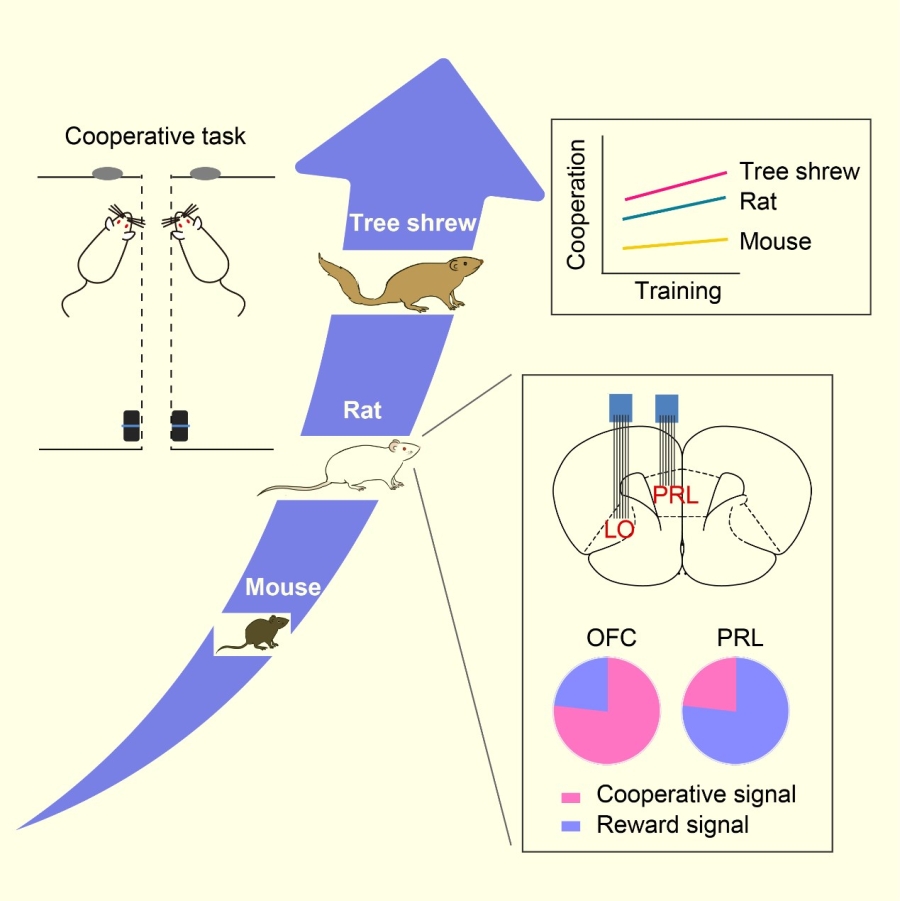Time:2021-11-17
A recent study published in Cell Reports reveals the evolution and the neural correlates of cooperation. This work was performed by researchers in Dr. WANG Zuoren’s Lab at the Institute of Neuroscience, Center for Excellence in Brain Science and Intelligence Technology of the Chinese Academy of Sciences and the State Key Laboratory of Neuroscience.
Cooperation in mammals is a high-level cognitively demanding behavior in which two or more individuals work together to achieve a common goal. Cooperative behavior is pervasive in nature and is pivotal to animal survival and the development of human society. The ability of humans to execute complex and elegant cooperative behaviors has been thought to contribute to our dominance in the animal kingdom. Therefore, the study of evolution of cooperative behaviors and the underlying mechanism will shed light on the understanding of modern society. However, why and how cooperative behavior evolved remain a mystery.
Previous studies in primates have found that cooperation is associated with consistent activation in brain areas related to both social and reward processing, including the orbitofrontal cortex (OFC) and the prefrontal cortex areas (PFC). However, there have been only limited studies on the cooperative behavior in non-primate mammals and the underlying neural mechanism.
To address the above questions, the researchers designed an automated temporal coordination paradigm suitable for quantitatively assessing cooperation in different mammalian species. In the paradigm, animals were required to poke the nose port cooperatively within a variety of fixed time windows (3 s, 2 s, 1 s, or 0.5 s) to obtain mutual rewards. Researchers found that both two-rat and three-rat cooperations could be achieved after training. The cooperation was mediated through social communications, especially during learning.
Taking advantage of the versatility of our behavioral paradigm, the researchers further tested and compared the cooperative behaviors of mice, rats, and tree shrews. They found that the tree shrews exhibited best cooperative ratios in the most difficult test condition (time window = 0.5 s). In addition, their poking number were less than rats, implying that their cooperation was more efficient than rats. In comparison, mice showed the worst performance with the lowest cooperative ratio in all testing conditions. Taken together, these findings indicate that increased cooperative abilities and enhanced cooperation efficiencies emerged as a function of the evolutionary hierarchy of the three species tested.
Following the behavior investigations, the researchers then studied the neural mechanism underlying cooperative behavior in rats. They recorded single unit activities in the OFC and the prelimbic cortex (PRL), two important areas in the brain’s reward circuitry. They found that many features of cooperative behavior were represented by the activities of neurons in the OFC and the PRL. The neurons responded differently when the role of a rat in cooperation was the initiator or the follower and when the cooperation succeeded or failed.
Importantly, the cooperation signals present in the OFC and the PRL were distinct from the reward signals. The researchers tested rats in conditions with different amounts of reward and analyzed the neuronal responses accordingly. They found that cooperation and reward were differentially represented in the OFC and the PRL. The cooperation signals are dominant in the OFC, while the PRL neuronal activities represented reward preferentially.
The new study established a quantitative cooperative behavioral paradigm and demonstrated the contribution of social communications to cooperation. The results revealed that cooperative ability and efficiency increases in species occupying different evolutionary hierarchies, providing evidence consistent with the evolution of mammalian cooperation. Furthermore, the cooperative roles and states are encoded by neurons in both the OFC and the PRL, and the cooperative signals and the reward signals are differently represented in the brain. The ability to distinguish multiple roles in social activities with other individuals may be a basis for empathy and perspective-taking, factors that are essential for establishing effective cooperation and developing swarm intelligence in human society. People with developmental and/or psychiatric disorders such as autism lack such ability to cooperate with others. Thus, a cooperative behavioral paradigm and neural feature recording may be helpful for the development of improved diagnostics and therapies for these disorders.
This work entitled “Evolution and Neural Representation of Mammalian Cooperative Behavior” was published online in Cell Reports on November 16, 2021. This work was performed by JIANG Mengping, WANG Miaoyaoxin, and SHI Qianqian, under the supervision of Dr. WANG Zuoren and, Dr. YANG Tianming, with help from WEI Lei, LIN Yongqin, WU Dingcheng, LIU Boyi, and with strong supports from NIE Xiupeng and Dr. XU Lin from Kunming Institute of Zoology, Chinese Academy of Sciences. Dr. QIAO Hong from Institute of Automation, Chinese Academy of Sciences contributed to this work. This work also benefited from the help from other laboratories and facilities at the Center for Excellence in Brain Sciences and Intelligence Technology of the Chinese Academy of Sciences. This project was supported by grants from the Chinese Academy of Sciences, the National Natural Science Foundation of China, and Shanghai Municipal Government.

Evolution and Neural Representation of Mammalian Cooperative Behavior (image by CEBSIT)
Figure legend: (Upper left): Rats communicate with their partner during the cooperative task. (Upper right): The behavioral performance of mice, rats and tree shrews in the cooperation task. (Bottom right): Neural representation of coopeative signals and reward signals in the OFC and PRL.
AUTHOR CONTACT:
WANG Zuoren
Center for Excellence in Brain Science and Intelligence Technology (Institute of Neuroscience), Chinese Academy of Sciences, Shanghai, China.
Email: zuorenwang@ion.ac.cn
 附件下载:
附件下载: